If you are new here, don’t forget to check our Discord Channel. It’s free for everyone!
If you are new to the deck and want to learn more about the basics, check other parts of the primer and the sideboard guide- you can find it here.
Other parts of the primer:
Part one: maindeck card chocies
Part three: mulligans, sequencing, and strange interactions
In the part one of the Hardened Scales primer I was talking about maindeck card choices. This section is focused on all playable sideboard options Scales have and what needs to be in your sideboard to compete and win in your local metagame.
Disenchant effects
Nature’s Claim
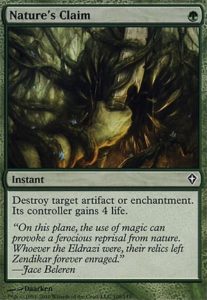
Claim is the original quintessential sideboard option for artifact/enchantment destruction. Destroying a target of any mana cost, for just the singular green mana, at the cost of giving your opponent four life. Also destroys your own permanents in a pinch, giving you your modular trigger/Hangarback thopters when you need them. Claim performs at its best against other Urza’s Saga decks, and I would always board it in if the opponent is playing this card. It also serves decently against 4C Omnath decks, atleast the ones running both Leyline Binding and Up the Beanstalk, as you will often have a good target, destroying a leyline binding before it can exile one of your permanents is a great way to pull ahead in tempo in this matchup, even at the cost of giving them 4 life.
You should always include some form of enchantment destruction in the sideboard, as Urza’s Saga will be a mainstay of the format for the rest of time, and destroying the card is very important in any game involving it. I currently still favour Nature’s Claim over other commonly used artifact/enchantment removal like Force of Vigor or Haywire Mite, as it provides the most consistent effect for the lowest cost.
Extra use against burn to blank Smash to Smithereens is good to keep in mind, as this is a 7-point life swing that they will be hard-pressed to recover from.
Nature’s claim *can* be brought in against Tron, but I’ve generally found this lacking, the only artifact worth destroying early is Expedition Map, and the long game against tron is one you will eventually lose the vast majority of the time so I would personally recommend against it.
Force of Vigor
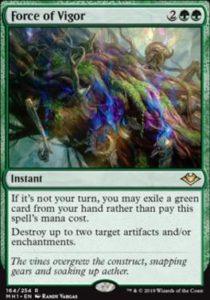
Force of Vigor serves the same purpose as Nature’s claim, but with the upside of destroying two cards, potentially having no mana cost, and not granting the opponent any life. The downside is the need to always have a certain critical mass of green cards in the deck, to be able to cast it for free as often as possible.
The generally accepted amount of cards to cast a spell like Force of Vigor for free consistently is 16, this is a number we cannot reach reasonably, even with four copies of Hardened Scales, Ancient Stirrings, and Force of Vigor itself, we still only reach 12. Add on the two to three Ozolith, the Shattered Spire, and we barely make short of the threshold, at the cost of a hefty deck building restriction. That is not even to mention the fact that it is generally very undesirable to exile your Hardened Scales with Force of Vigor, as it is vastly superior to just cast it turn one, this leaves you with a mere 10-11 cards that you actively want to pitch to the Force.
Now this doesn’t mean Force of Vigor is all bad, it definitely has upside as proven by it being the most commonly played green artifact/enchantment destruction spell by a wide margin. If you do play the card, make sure to do so in a meta where the increased efficiency and speed of Force of Vigor is important. Lots of hammer time, Emry Breach combo decks, and mirror matches are a great playing field for Force of Vigor to do its best work.
I find Force to be lacking against Amulet Titan. At least compared to its single target counterparts, as a turn one Amulet of Vigor still demands an answer, and even without a second target for your Force of Vigor, you still have to remove the Amulet as soon as possible. Still board it in against them of course, but keep this in mind when making your sideboard.
Haywire Mite
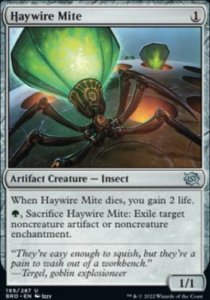
The third and final option for sideboard artifact/enchantment hate, Haywire mite has the massive advantage of being a one mana artifact, therefore adding an additional 4 copies to your deck with Urza’s Saga.
It gains you two life which, just like Nature’s Claim, makes it worthwhile against burn decks.
It’s also the only piece that exiles instead of destroying, which lets you get rid of the oh so important One Ring, as well as any Kaldra Compleat that Hammer Time players might have brought to the table. With the recent addition of Agatha’s Soul Cauldron, the insect has received another boon. By exiling the Mite under your Cauldron, all of your creatures gain access to both a one mana sacrifice outlet(as long as you have a target) and the ability to exile an opponent’s Urza’s Saga or other important piece.
Mite is quite well positioned at the moment, and there should always be a single copy in your 75. Even though it costs the most mana of the removal options, and can’t target creatures, it’s a great choice for your sideboard.
Urza’s Saga’s silver bullets
(Haywire Mite was already mentioned above since it fits to more than one section)
Pithing Needle
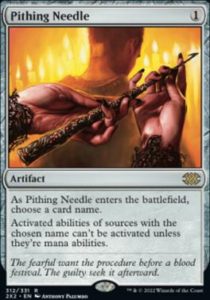
Needle is another Saga piece that should always have a slot in your 75.
It should be brought in against any deck relying on activated abilities, including but not limited to: Most decks using Urza’s Saga, Yawgmoth, Amulet Titan for Boseiju, and some decks using The One Ring. It can be useful against Murktide and Scam to stop Engineered Explosives, this does require a meta read to know how many copies they are playing, if they’re on two or more, and don’t play other dedicated artifact removal(Abrade/Cast into the Fire for Murktide. Hidetsugu consumes all/Kolaghan’s Command for Scam) the card can completely disable their ability to trade their removal for you at better value than one for one, which is great.
Needle can be a part of the maindeck in certain metas, mainly ones with lots of Hammer and Yawgmoth.
Learning what to name with Needle is mostly experience, but I’ll provide a shortlist for what to name against the most common decks in the format, included if you are running it mainboard. If a sideboard option is not included, that means the card should never be in your deck postboard:
- Scam
Mainboard: A black fetchland they have not yet used
Sideboard: Engineered Explosives - Murktide
Mainboard: Scalding Tarn
Sideboard: Engineered Explosives - Rhinos
Mainboard: Boseiju or Misty Rainforest - Burn
Mainboard: A red fetchland they have not yet used, or Roiling Vortex if you have a Shadowspear out and they have it in play. - 5C Zoo
Mainboard: Wooded Foothills or Windswept Heath - Hardened Scales
Mainboard: Whichever card you would lose to hardest between Inkmoth Nexus, Walking Ballista, Arcbound Ravager, or Agatha’s Soul Cauldron. Preferably one that does not affect your hand or board.
Sideboard: Idem - Merfolk
Mainboard: Aether Vial - Jund Saga
Mainboard: Urza’s Saga, Wrenn and Six, or Boseiju - 4C control
Mainboard: The One Ring
Sideboard: The One Ring, Boseiju, who Endures(better side as they have additional copies) - Tron
Mainboard: Karn, the Great creator, The One Ring, or Oblivion Stone
Sideboard: Karn, the Great Creator, The One Ring, or Oblivion Stone - MonoB Coffers
Mainboard: Karn, the Great Creator, or The One Ring
Sideboard: Karn, the Great Creator, or The One Ring - Yawgmoth
Mainboard: Yawgmoth.
Sideboard: Yawgmoth.
Note: It can be tempting to name grist, especially when it’s already in play, this is generally incorrect as Grist is a very beatable card for us, Yawgmoth is often game-ending however. Grist should only be named if the game is guaranteed lost to a grist activation - Living End
Mainboard: Oliphaunt - Amulet
Mainboard: Boseiju, who Endures
Sideboard: Boseiju, who Endures - Hammer time
Mainboard: Colossus Hammer(for Puresteel Paladin), Stoneforge Mystic
Sideboard: Colossus Hammer, Stoneforge Mystic
Note: Rarely Inkmoth Nexus can be a good name, if you know they will kill you with it and you have no other options. - Creativity
Mainboard: Wrenn and Six, Teferi, Time Raveler - Underworld Breach combo
Mainboard: Grinding Station, Emry
Sideboard: Grinding Station, Emry
These are general guidelines and can absolutely change game to game! Remember that when getting a Needle of Urza’s Saga, your opponent cannot respond in between you searching and putting the Needle into play, this lets you disable any active fetchlands which can be the correct play if the tempo gain would put you at a significant advantage.
If your opponent has an Engineered Explosives available, and you have a Pithing Needle you are intending to fetch, do not tap the Saga for mana *or* a construct, just pass priority to the opponent. If they let it happen, you can then grab the Pithing Needle to protect any of your permanents already in play from the Explosives. If they respond by activating their Explosives, you still get to activate the Saga afterwards to make a construct.
Against any deck with fetchlands Needle can be a good get if they’re not paying attention and let the ability resolve before using their fetchland in play.
Grafdigger’s Cage
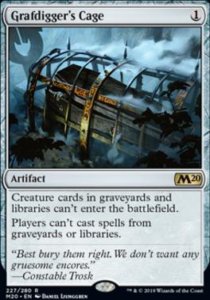
Grafdigger’s Cage is a strong card primarily for Yawgmoth, as well as hitting Underworld Breach decks and the occasional Dredge opponent.
It’s mostly a meta call for when Yawgmoth is prevalent, as this deck is a very tough matchup that can use the extra help, paired with Needle and Tamiyo’s Safekeeping/Welding Jar, you can do a pretty good prison deck impression vs them, and hopefully slowly close out the game with your superior creatures.
Notably does not work against Living End and Indomitable Creativity, as these cards both exile their creatures first before putting them onto the battlefield.
Important! With Grafdigger’s Cage in play, you cannot grab Zabaz from your Urza’s Saga, as it is a creature being put into play from the library.
Relic of Progenitus

A slow graveyard removing engine, as well as a oneshot graveyard clearing effect that gives you the card back. Decent when the meta was slower and Murktide was top dog, now mostly outclassed due to a shifting metagame and the printing of Agatha’s Soul Cauldron doing its job much better.
Creature removal
Dismember
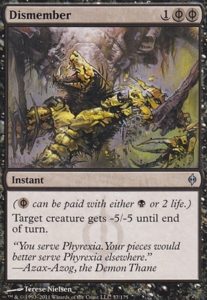
Dismember is our best choice for universal creature removal, and can kill the majority of important targets in modern for just one mana. Can also function as a bad sacrifice outlet when you are in need of one, although this should never be a primary use.
It should be brought in against all creature decks: Murktide to kill their early creatures and reduce pressure, Scam to get rid of Dauthi and 4/4 Fury, Hammer to kill a Puresteel or Stoneforge before they get to do their thing, and combo decks that rely on a creature to perform the combo (like Emry Breach, or Yawgmoth).
Dismember is at its best when trading cards one for one in a matchup favours you, as it generally does being the Urza’s Saga deck. Cases where this is not true are 4C omnath variants, and Amulet Titan. With the latter it’s a bit more of an edge case, as killing an Azusa or Dryad can really swing the match in your favour, and this moreso depends on how many other cards you are already bringing in.
There should always be some form of creature removal in your sideboard, with the other option being Galvanic Blast.
Galvanic Blast

I must admit that I haven’t yet played with this card, as I’ve been a Dismember loyalist since the beginning, but it wouldn’t be terrible if you up the red mana count in your deck a little. Here are some upsides and downside for running it vs Dismember;
Upsides:
- Kills an early Ragavan, Dauthi, Goblin guide, or Dragon’s Rage Channeler without the life cost
- Can target a planeswalker like Karn, the Great Creator to unlock your other creatures
- Can target your opponent for the final points of damage
Downsides:
- Needs red mana, which requires some changes to your mana base to facilitate this more often. Can still be dead in hand as your sources of red mana are unlikely to be more than 10 in the deck
- Will be Shock more often than you like, which will not kill a Yawgmoth, Dryad of the Ilysan grove, Fury, Ledger Shredder, or Murktide.
- Opponent’s can respond to it by destroying one of your artifacts to remove your metalcraft, which can lead to massive blowouts.
Overall I would recommend sticking to dismember, but it’s not an offensive choice.
Anti-cascade options
Chalice of the Void
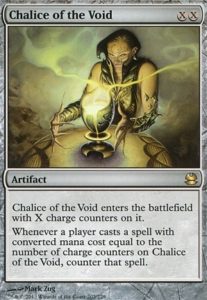
Premier anti-cascade hate and at the moment of writing, the most played card in Modern. For just 0 mana you can turn off your opponents entire deck when facing Living End or Rhinos, and it doesn’t get much better than that.
Other decks where its useful are mainly ones involving Mishra’s Bauble and Underworld Breach, as this combination of value is often hard to beat.
The card pairs great with Welding Jar to protect it from a potential Force of Vigor, Flame of Anor, or Foundation Breaker, just make sure to cast the Jar *before* you cast the Chalice.
Soulless Jalier

The second of three anti-cascade options, this one is notable for being a creature, with all the benefits and drawbacks that come with it. It additionally stops any creatures being reanimated, which is great in a meta of Yawgmoth, Goryo’s reanimator decks, and even Jund Creativity.
This card is *not* primarily graveyard hate, which I feel I must reiterate, it does not replace Grafdigger’s cage or other specific graveyard hate cards, but comes in addition to them, while also attacking cascade decks. Does great work vs any Thopter Foundry/Sword of the Meek deck.
Void Mirror

The last card you can put in the side to deal with Rhinos, Living End, and the sometimes occurring Glimpse of Tomorrow decks. Void mirror’s main upside is that it prevents Force of Vigor from being cast for free to immediately clear out your headpiece. This is sadly slightly outdated as between Otawara, Boseiju, Brazen Borrower, and others, cascade decks now have plenty of ways to still clear out your hate piece without relying entirely on free spells.
Do not board this card in against decks looking to evoke Elementals, as merely stopping Scam from evoking Fury on turn 3 and beyond is not going to help you in the matchup, spending two mana and a card sets you much further behind than a potential evoked Fury ever could, not to mention they can still just pay five mana for it, which they will likely reach with you having wasted your turn on this. The same goes for 4C elemental piles.
Void Mirror is decent against tron, and can be brought in while on the draw to try and cheese them out when they don’t have green mana available, it is much superior against eldrazi tron, although that deck has fallen out of the meta mostly. Do be careful when casting it, as having no coloured lands available will disable your own spells. As with Chalice, cast your Welding Jar *before* your Void Mirror.
Always bring atleast two copies of cascade hate in your sideboard, be it Chalice, Jailer, or Void mirror. Adjust which one is superior depending on the rest of the meta.
The rest
Tamiyo’s Safekeeping

Safekeeping is our protection card in the sideboard, that can target any permanent. It should be brought in against most interactive decks to save your key cards from removal in the turns you need it.
Safekeeping provides better protection on winning turns than Welding Jar, as it protects from every form of targeted removal, and does not tap your creature when saving it.
It can be used on Inkmoth Nexus *before* activating it, to give it hexproof before it ever becomes a creature, useful when expecting multiple copies of damage based removal like Lightning Bolt and Unholy Heat.
The card is at its best in highly interactive metas, with 4C Omnath, Rhinos, Scam, and Murktide at the top of the charts.
It’s also good when you are trying to protect a piece that completely shuts down a deck, like Pithing Needle or Grafdigger’s Cage against Yawgmoth, or Chalice of the Void against cascade decks.
Damping Sphere
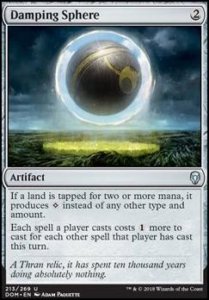
Damping Sphere is mainly tech against Amulet Titan, as the matchup is quite awful and to have a good chance you either need to be lucky, or dedicate a significant amount of slots to it. It buys you a good chunk of time against these big mana decks as long as it sticks around, which can be enough to set up a strong boardstate they can’t disrupt or hit through. The card also deals good collateral damage to Tron, Lotus Field decks, and anyone picking up a deck that has Grapeshot as its win condition. It should be brought in against all of these.
Do not bring it in against Mono Black Coffers, as reaching high amounts of mana is not their main plan, and not the way they win against us.
Emrakul, the Aeons Torn
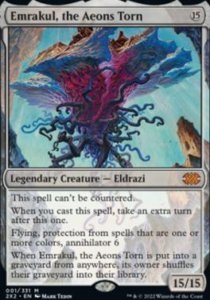
This card is for Mill and only Mill. It should be in your sideboard for small local tournaments where you are expecting a Mill opponent to be present, that’s pretty much it.
Syr Ginger, the Meal Ender
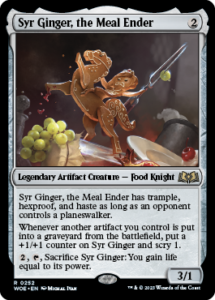
Now this card has been an interesting extra surprise from Wilds of Eldraine, with the Cauldron taking the main stage it has been relegated to a footnote, but still, this card is worth discussing. It does by far its best work against decks that run both Wrenn and Six, and Teferi, Time Raveler. These are planeswalkers that you can safely leave in play, granting your Syr Ginger its hexproof and trample to keep it a safe consistent threat that’s near impossible to answer for your opponents. In metas with lots of 4C control and/or Creativity, this is definitely one worth considering.
You *can* board it in against decks running Karn, the Great Creator, but I find this lacking. Karn is a priority target that you cannot leave alive, so merely having a 3/1 haste to make it easier to kill is not good enough for me.
